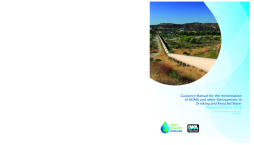
BOOK
Guidance Manual for the Minimisation of NDMA and other Nitrosamines in Drinking and Recycled Water
Gayle Newcombe | Julie Culbert | Jim Morran
(2014)
Additional Information
Book Details
Abstract
N-nitrosodimethylamine (NDMA) is a nitrogen-containing organic compound that has known carcinogenic properties. NDMA has been a health concern for some industries for a number of years as it is used in rubber formulations, as a fire retardant, antioxidant, additive for lubricants and softener of copolymers; it is also a degradation product of dimethylhydrazine, an additive to rocket fuel. Most people are exposed to NDMA via a number of diverse routes including cigarette smoke (actively or passively) and processed foods, for example smoked meat products. However, it has only come to the attention of the international water industry since it was recognised as a disinfection by-product (DBP) of chloramination or chlorination in the presence of ammonia.
The aim of this guidance manual is to answer commonly asked questions about this emerging issue, such as:
- How do they come to be in drinking water and recycled water and what • concentrations are “normal”?
- What regulatory/guidance levels have been imposed in Australia and elsewhere?
- How are they formed? What are the risk factors for the occurrence of nitrosamines in my system?
- What can we do to control them?
- What are the implications for the drinking and recycled water industry, and in particular for public health?
This book is co-published with Water Research Australia.
Table of Contents
| Section Title | Page | Action | Price |
|---|---|---|---|
| Cover\r | Cover | ||
| CONTENTS | iii | ||
| FIGURES | iv | ||
| TABLES | iv | ||
| INTRODUCTION | 1 | ||
| OCCURRENCE | 2 | ||
| GUIDELINES | 4 | ||
| FORMATION | 5 | ||
| Chemistry of chlorination and chloramination – some basics | 5 | ||
| Pathways for the formation of nitrosamines | 7 | ||
| IDENTIFYING SYSTEMS AT RISK | 9 | ||
| Drinking water | 9 | ||
| Recycled water | 9 | ||
| Risk checklists | 10 | ||
| MONITORING FOR NITROSAMINES AND PRECURSORS | 11 | ||
| General principles | 11 | ||
| Drinking water | 12 | ||
| Benchmarking | 12 | ||
| Investigative sampling | 12 | ||
| Routine monitoring | 13 | ||
| Additional monitoring | 13 | ||
| Recycled water | 13 | ||
| Effluent to be used for augmentation of drinking water | 13 | ||
| Effluent will not be used for augmentation of drinking water | 14 | ||
| CONTROL MEASURES | 15 | ||
| Background | 15 | ||
| Minimising formation | 15 | ||
| Removal of nitrosamines | 15 | ||
| Applying control measures | 17 | ||
| At the source | 17 | ||
| Drinking and recycled water | 17 | ||
| In the plant | 17 | ||
| Drinking water | 17 | ||
| Pre-oxidation | 17 | ||
| Powdered activated carbon | 17 | ||
| Coagulation and flocculation | 17 | ||
| Membrane filtration | 18 | ||
| Rapid filtration, recycling | 18 | ||
| SUMMARY | 20 | ||
| REFERENCES | 22 |
